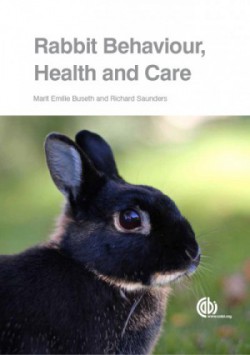How to enrich a rabbit`s life
 Small rabitt, great urge. P: Katarina Vallbo
Small rabitt, great urge. P: Katarina Vallbo
Enrichments are defined as adaptions in the environment aimed at increasing the animals`wellbeing. Such environmental improvements will provide captive animals with opportunities so that they can perform natural behaviour and consequently improve their welfare. The result of different types of enrichments might be an increase in activity as well as reduction in sterotypies, such as bar-gnawing. Even fearfulness has declined in animals given enrichment. Environmental enrichment is thus a simple and effective means of improving animal welfare in any species.
Enricments can roughly be divided into five groups, and I will explain them based on rabbits`needs. As we will see, it is also quite possible that a given enrichment belongs to several groups.

Food-based enrichments
Rabbits are herbivores that spend most of their awake time grazing, processing food and eating nutritionally -poor plants. To encourage this behaviour it is important to give a hay-based diet. In addition to prolonging the feeding experience by hiding other food in cardboard boxes, one should make the rabbit hunt for vegetable hidden around the apartment, or offer the daily amount of high-fibre pellets in the same manner. Spending lots of time nibbling hay prevents boredom and maintanins a healthy digestions. The same applies to various chewing objects.

Photo: Malin Ragø Jacobsen
Physical enrichments
Rabbits are dependent on physical activity and exercise for maintaining their wellbeing and health. Good enclosure designs for rabbits incorporate both a large space and the possibility to move vertically on different platforms, and of course hideouts and chewing objects, such as tunnels of unpeeled willow or similar. Activities such as digging and gnawing should also be made possible. Digging is a behaviour that many rabbits attemt to carry out, or they indulge in displacement behaviours suchs as scratching carpets, etc. Providing escape-free digging areas outside, or bringing trays or boxes of earth or other substrates inside (e.g. turf, deep boxes of hay and even snow) helps fulfil their need for digging.
 Marikken is digging P: Marit E Buseth
Marikken is digging P: Marit E Buseth
Sensory enrichments
Rabbits are not as visual as humans, and their main sense are smell and hearing. It is therefore stimulating and activating for the rabbit to be exposed to various fragrances and use its nose to search for food. Put some fresh herbs or vegetables here and there and let the rabbit find them.
Rabbits have good hearing, so talk to the rabbits, let them learn how to recognize your voice and tone. Rabbits can easily learn to distinguish between a cuddly voice and a strict "no" when trying to chew on something forbidden. Offer them a radio with talking and classical music sometimes, and they will become accustomed to variety of sounds.
 Nemi and Noah P: Tanja Furuset
Nemi and Noah P: Tanja Furuset
Social enrichment
Rabbits are gregarious and incredibly social animals. Ensure your rabbit has suitable company, and make sure all animals are neutered, introduced properly and have a suffivently large living area.
Harald, Melis and Even P:Marit E Buseth
Cognitive enrichment
Many domesticated rabbits live in simple and monotonous environments, where they are not being challenged at all. Problem solving, exploration and play seem important to counteract boredom and apathy. Let them work for obtaining food, give them access to places they do not tend to be and see them eagerly explore the area, relocate the furniture in your or your rabbit`s`house and observe the busy bunny.
 Kaizer and Constanza Photo: Anett Nyborg
Kaizer and Constanza Photo: Anett Nyborg
Captivity often prevents animals from performing their natural behaviour. In the case of rabbits, restrictions on the ability to move about, have serious consequenses, and one should have knowledge on the species`needs and prefernces when considering types of living arrangements. Get a thorough understanding of the rabbits`natural habitat, health, behaviour, social behaviour and all topics vital to offer them suitable living conditions in a domestic setting in Rabbit Behaviour, Health and Care.

In memory of Petter P: Jens Petter Salvesen
 Family activity P.Marit Emilie Buseth
Family activity P.Marit Emilie Buseth
 Crowded P:Marit Emilie Buseth
Crowded P:Marit Emilie Buseth
 Melis, the cover bunny P: Marit Emilie Buseth
Melis, the cover bunny P: Marit Emilie Buseth

 Mogens P: Fie Lundgaard Frandsen
Mogens P: Fie Lundgaard Frandsen
 Petter Photo: Marit Emilie Buseth
Petter Photo: Marit Emilie Buseth

